Alright, I develop an application for a client, is time to implement the push notification for one more time 
At first download the latest google-play-services which is <b style="color:red">target:android-23</b>, seems that has some conflicts when tried to obfuscate it (using Eclipse / Android 6.0 for compile / ant) some of the errors :
^wtf?
, whatever I restore back the <b style="color:red">target:android-16</b>!! Plays 100%
the steps :
<b style="color:red">1-</b>On androidmanifest.xml add inside application tag :
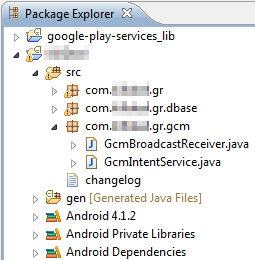
then add the needed files for into separate package I will name it gcm, so we have com.text.gr.gcm
On your mainactivity (does matter if your application has a splashscreen, this will be added to mainactivity)
proguard rules
the steps for Google Cloud Platform
you go to https://console.cloud.google.com/, create a project, this project will taken a <b style="solor:red">Project Number</b> write it down!
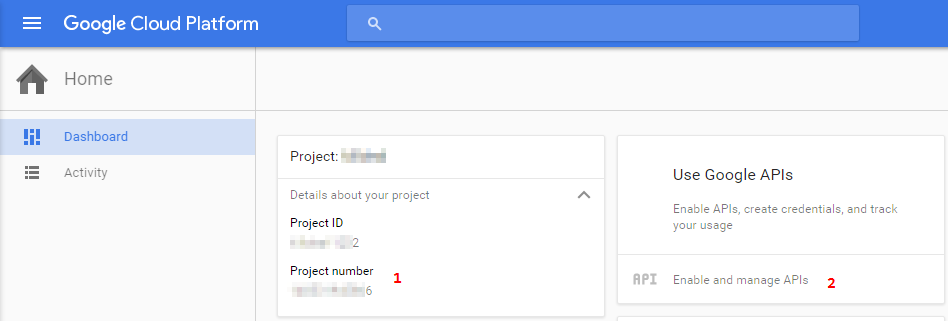
goto <b style="solor:red">Enable and manage APIs</b> select the Mobile > Cloud messaging and enable it!
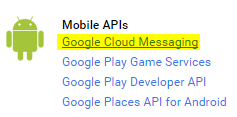
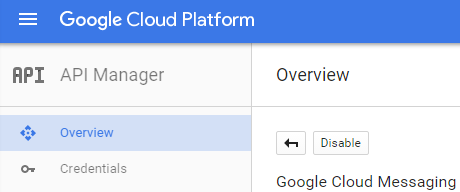
click credentials on ^left and create a server or browser key

I dont use the Domain Verification tab, I went to https://www.google.com/webmasters/tools/home click add property and verify by html file, my domain. In this way I can use Server and Browser keys....
at the time of the article 3/4/2016, my old application (https://www.pipiscrew.com/works/gcm-push-tested/), works, but send empty message on the device :
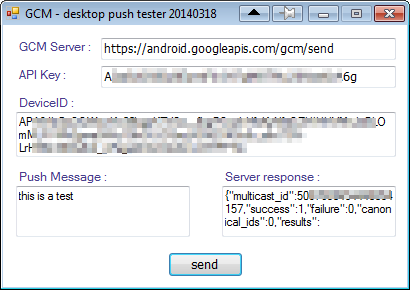
but lets
implement the PHP version!
source - http://iconhandbook.co.uk/reference/chart/android/

At first download the latest google-play-services which is <b style="color:red">target:android-23</b>, seems that has some conflicts when tried to obfuscate it (using Eclipse / Android 6.0 for compile / ant) some of the errors :
JavaScript:
com.google.android.gms.internal.zzlh: can't find dynamically referenced class com.facebook.FacebookSdk^wtf?
, whatever I restore back the <b style="color:red">target:android-16</b>!! Plays 100%
the steps :
<b style="color:red">1-</b>On androidmanifest.xml add inside application tag :
JavaScript:
//androidmanifest.xml sample
<application
android:name=".Dynomite"
android:allowBackup="true"
android:icon="@drawable/ic_launcher"
android:label="@string/app_name"
android:logo="@drawable/actionbar_logo_red"
android:theme="@style/AppTheme" >\
<!-- GCM START -->
<meta-data
android:name="com.google.android.gms.version"
android:value="@integer/google_play_services_version" />
<receiver
android:name="com.test.gr.gcm.GcmBroadcastReceiver"
android:permission="com.google.android.c2dm.permission.SEND" >
<intent-filter>
<!-- Receives the actual messages. -->
<action android:name="com.google.android.c2dm.intent.RECEIVE" />
<category android:name="com.test.gr" />
</intent-filter>
</receiver>
<service android:name="com.test.gr.gcm.GcmIntentService" />
<!-- GCM END -->
</application>
then add the needed files for into separate package I will name it gcm, so we have com.text.gr.gcm
JavaScript:
//GcmBroadcastReceiver.java
package com.test.gr.gcm;
import android.app.Activity;
import android.content.ComponentName;
import android.content.Context;
import android.content.Intent;
import android.support.v4.content.WakefulBroadcastReceiver;
/**
* This {@code WakefulBroadcastReceiver} takes care of creating and managing a
* partial wake lock for your app. It passes off the work of processing the GCM
* message to an {@code IntentService}, while ensuring that the device does not
* go back to sleep in the transition. The {@code IntentService} calls
* {@code GcmBroadcastReceiver.completeWakefulIntent()} when it is ready to
* release the wake lock.
*/
public class GcmBroadcastReceiver extends WakefulBroadcastReceiver {
@Override
public void onReceive(Context context, Intent intent) {
// Explicitly specify that GcmIntentService will handle the intent.
ComponentName comp = new ComponentName(context.getPackageName(), GcmIntentService.class.getName());
// Start the service, keeping the device awake while it is launching.
startWakefulService(context, (intent.setComponent(comp)));
setResultCode(Activity.RESULT_OK);
}
}
//GcmIntentService.java
package com.test.gr.gcm;
import android.app.IntentService;
import android.app.NotificationManager;
import android.app.PendingIntent;
import android.content.Context;
import android.content.Intent;
import android.content.SharedPreferences;
import android.graphics.BitmapFactory;
import android.media.RingtoneManager;
import android.net.Uri;
import android.os.Bundle;
import android.preference.PreferenceManager;
import android.support.v4.app.NotificationCompat;
import android.util.Log;
import com.google.android.gms.gcm.GoogleCloudMessaging;
import com.test.gr.MainActivity;
import com.test.gr.R;
/**
* This {@code IntentService} does the actual handling of the GCM message.
* {@code GcmBroadcastReceiver} (a {@code WakefulBroadcastReceiver}) holds a
* partial wake lock for this service while the service does its work. When the
* service is finished, it calls {@code completeWakefulIntent()} to release the
* wake lock.
*/
public class GcmIntentService extends IntentService {
public static final int NOTIFICATION_ID = 1;
private NotificationManager mNotificationManager;
NotificationCompat.Builder builder;
public GcmIntentService() {
super("GcmIntentService");
}
private SharedPreferences preferences;
public static final String TAG = "GCM CC";
@Override
protected void onHandleIntent(Intent intent) {
Bundle extras = intent.getExtras();
GoogleCloudMessaging gcm = GoogleCloudMessaging.getInstance(this);
// The getMessageType() intent parameter must be the intent you received
// in your BroadcastReceiver.
String messageType = gcm.getMessageType(intent);
preferences = PreferenceManager.getDefaultSharedPreferences(getBaseContext());
if (!extras.isEmpty()) { // has effect of unparcelling Bundle
/*
* Filter messages based on message type. Since it is likely that GCM will be
* extended in the future with new message types, just ignore any message types you're
* not interested in, or that you don't recognize.
*/
if (GoogleCloudMessaging.MESSAGE_TYPE_SEND_ERROR.equals(messageType)) {
Log.d(TAG, "Send error: " + extras.toString());
} else if (GoogleCloudMessaging.MESSAGE_TYPE_DELETED.equals(messageType)) {
Log.d(TAG, "Deleted messages on server: " + extras.toString());
// If it's a regular GCM message, do some work.
} else if (GoogleCloudMessaging.MESSAGE_TYPE_MESSAGE.equals(messageType)) {
// Post notification of received message.
String title = extras.getString("title", null);
String message = extras.getString("description", null);
String link = extras.getString("link", null);
sendNotification(title, message, link);
Log.i(TAG, "Received: " + extras.toString());
}
}
// Release the wake lock provided by the WakefulBroadcastReceiver.
GcmBroadcastReceiver.completeWakefulIntent(intent);
}
// Put the message into a notification and post it.
// This is just one simple example of what you might choose to do with
// a GCM message.
private void sendNotification(String title, String msg, String link) {
mNotificationManager = (NotificationManager)
this.getSystemService(Context.NOTIFICATION_SERVICE);
Intent intent = new Intent(this, MainActivity.class);
intent.putExtra("link", link);
PendingIntent contentIntent = PendingIntent.getActivity(this, 0, intent, PendingIntent.FLAG_CANCEL_CURRENT);
NotificationCompat.Builder mBuilder = new NotificationCompat.Builder(this)
.setLargeIcon(BitmapFactory.decodeResource(getBaseContext().getResources(), R.drawable.ic_launcher))
.setSmallIcon(R.drawable.ic_launcher)
.setContentTitle(title)
.setStyle(new NotificationCompat.BigTextStyle()
.bigText(msg))
.setContentText(msg);
// Set the notification vibrate option
if (preferences.getBoolean("notifications_new_message_vibrate", true)) {
mBuilder.setVibrate(new long[]{1000, 1000, 1000, 1000, 1000});
}
// Set the notification ringtone
if (preferences.getString("notifications_new_message_ringtone", null) != null) {
mBuilder.setSound(Uri.parse(preferences.getString("notifications_new_message_ringtone", null)));
} else {
Uri alarmSound = RingtoneManager.getDefaultUri(RingtoneManager.TYPE_NOTIFICATION);
mBuilder.setSound(alarmSound);
}
// Show only if the notification are enabled
if (preferences.getBoolean("notifications_new_message", true)) {
mBuilder.setContentIntent(contentIntent);
mNotificationManager.notify(NOTIFICATION_ID, mBuilder.build());
}
}
}On your mainactivity (does matter if your application has a splashscreen, this will be added to mainactivity)
JavaScript:
//MainActivity.java
// GCM
public static final String PROPERTY_REG_ID = "notifyId";
private static final String PROPERTY_APP_VERSION = "1";
GoogleCloudMessaging gcm;
SharedPreferences preferences;
String reg_cgm_id;
static final String TAG = "MainActivity";
@Override
protected void onCreate(Bundle savedInstanceState) {
.
.
// //////////////////////////////////////////////////////////////
// GCM -
if (checkPlayServices()) {
gcm = GoogleCloudMessaging.getInstance(getApplicationContext());
String reg_cgm_id = getRegistrationId(getApplicationContext());
Log.i(TAG, "Play Services Ok.");
if (reg_cgm_id == null || reg_cgm_id.isEmpty()) {
Log.i(TAG, "Find Register ID.");
registerInBackground();
}
} else {
Log.i(TAG, "No valid Google Play Services APK found.");
}
}
/**
* Check the device to make sure it has the Google Play Services APK. If it
* doesn't, display a dialog that allows users to download the APK from the
* Google Play Store or enable it in the device's system settings.
*/
private boolean checkPlayServices() {
int resultCode = GooglePlayServicesUtil.isGooglePlayServicesAvailable(MainActivity.this);
if (resultCode != ConnectionResult.SUCCESS) {
if (GooglePlayServicesUtil.isUserRecoverableError(resultCode)) {
GooglePlayServicesUtil.getErrorDialog(resultCode, this, 9000).show();
} else {
Log.i(TAG, "This device is not supported.");
}
return false;
}
return true;
}
/**
* Gets the current registration ID for application on GCM service.
* If result is empty, the app needs to register.
*/
private String getRegistrationId(Context context) {
String registrationId = General.get_pref(this).getString(PROPERTY_REG_ID, "");
if (registrationId.isEmpty()) {
Log.i(TAG, "Registration not found.");
return "";
}
// Check if app was updated; if so, it must clear the registration ID
// since the existing regID is not guaranteed to work with the new
// app version.
int registeredVersion = General.get_pref(this).getInt(PROPERTY_APP_VERSION, Integer.MIN_VALUE);
int currentVersion = getAppVersion(context);
if (registeredVersion != currentVersion) {
Log.i(TAG, "App version changed.");
return "";
}
return registrationId;
}
/**
* Registers the application with GCM servers asynchronously.
*/
private void registerInBackground() {
new AsyncTask<Void, Void, String>() {
@Override
protected String doInBackground(Void... params) {
String msg = "";
try {
if (gcm == null) {
gcm = GoogleCloudMessaging.getInstance(MainActivity.this);
}
reg_cgm_id = gcm.register("**you project number**");
msg = "Device registered, registration ID=" + reg_cgm_id;
Log.d(TAG, "ID GCM: " + reg_cgm_id);
// You should send the registration ID to your server
sendRegistrationIdToBackend();
} catch (IOException ex) {
msg = "Error :" + ex.getMessage();
}
return msg;
}
@Override
protected void onPostExecute(String msg) {
}
}.execute(null, null, null);
}
/**
* Stores the registration ID and the app versionCode in the application SharedPreferences
*/
private void storeRegistrationId(Context context, String regId) {
int appVersion = getAppVersion(context);
Log.i(TAG, "Saving regId on app version " + appVersion);
SharedPreferences.Editor editor = General.get_pref(this).edit();
editor.putString(PROPERTY_REG_ID, regId);
editor.putInt(PROPERTY_APP_VERSION, appVersion);
editor.commit();
}
/**
* Sends the registration ID to your server
*/
private void sendRegistrationIdToBackend() {
//your own implementation to send the current device token (stored to public var reg_cgm_id) to your web server
//only when server got it, call the
storeRegistrationId(MainActivity.this, reg_cgm_id);
}
/**
* @return Application's version code from the {@code PackageManager}.
*/
private static int getAppVersion(Context context) {
try {
PackageInfo packageInfo = context.getPackageManager().getPackageInfo(context.getPackageName(), 0);
return packageInfo.versionCode;
} catch (PackageManager.NameNotFoundException e) {
// should never happen
throw new RuntimeException("Could not get package name: " + e);
}
}proguard rules
JavaScript:
//google-play-services_lib -- proguard-project.txt
-dontskipnonpubliclibraryclassmembers
-keep class * extends java.util.ListResourceBundle {
protected Object[][] getContents();
}
# Keep SafeParcelable value, needed for reflection. This is required to support backwards
# compatibility of some classes.
-keep public class com.google.android.gms.common.internal.safeparcel.SafeParcelable {
public static final *** NULL;
}
# Keep the names of classes/members we need for client functionality.
-keepnames @com.google.android.gms.common.annotation.KeepName class *
-keepclassmembernames class * {
@com.google.android.gms.common.annotation.KeepName *;
}
# Needed for Parcelable/SafeParcelable Creators to not get stripped
-keepnames class * implements android.os.Parcelable {
public static final ** CREATOR;
}
//com.test.gr -- proguard-project.txt
# Keel all googleclasses
-keep class com.google.** { *; }
-dontwarn com.google.**the steps for Google Cloud Platform
you go to https://console.cloud.google.com/, create a project, this project will taken a <b style="solor:red">Project Number</b> write it down!

goto <b style="solor:red">Enable and manage APIs</b> select the Mobile > Cloud messaging and enable it!


click credentials on ^left and create a server or browser key

I dont use the Domain Verification tab, I went to https://www.google.com/webmasters/tools/home click add property and verify by html file, my domain. In this way I can use Server and Browser keys....
at the time of the article 3/4/2016, my old application (https://www.pipiscrew.com/works/gcm-push-tested/), works, but send empty message on the device :

but lets
implement the PHP version!
JavaScript:
//index.php
<?php
if ($_SERVER['REQUEST_METHOD'] === 'POST') {
$password_string = mysql_escape_string($_POST["password"]);
if ($password_string!="yourpasswordhere") //doesnt compare the mail
{
die("error!");
}
else {
//show the rest!
}
} else { //login system ?>
<!DOCTYPE html>
<html lang="en">
<head>
<meta charset="utf-8">
<meta http-equiv="X-UA-Compatible" content="IE=edge">
<meta name="viewport" content="width=device-width, initial-scale=1">
<title>Test - Push Panel</title>
<link href="assets/bootstrap.min.css" rel="stylesheet">
<style>
body {
padding-top: 40px;
padding-bottom: 40px;
background-color: #eee;
}
.form-signin {
max-width: 330px;
padding: 15px;
margin: 0 auto;
}
.form-signin .form-signin-heading,
.form-signin .checkbox {
margin-bottom: 10px;
}
.form-signin .checkbox {
font-weight: normal;
}
.form-signin .form-control {
position: relative;
height: auto;
-webkit-box-sizing: border-box;
-moz-box-sizing: border-box;
box-sizing: border-box;
padding: 10px;
font-size: 16px;
}
.form-signin .form-control:focus {
z-index: 2;
}
.form-signin input[type="email"] {
margin-bottom: -1px;
border-bottom-right-radius: 0;
border-bottom-left-radius: 0;
}
.form-signin input[type="password"] {
margin-bottom: 10px;
border-top-left-radius: 0;
border-top-right-radius: 0;
}
</style>
</head>
<body>
<div class="container">
<form class="form-signin" method="POST" action="">
[SIZE=6]Please sign in[/SIZE]
<label for="mail" class="sr-only">Email address</label>
<input type="email" name="mail" class="form-control" placeholder="Email address" required autofocus>
<label for="password" class="sr-only">Password</label>
<input type="password" name="password" id="password" class="form-control" placeholder="Password" required>
<button class="btn btn-lg btn-primary btn-block" type="submit">Sign in</button>
</form>
</div> <!-- /container -->
</body>
</html>
<?php exit; } ?>
<!DOCTYPE html>
<html lang="en">
<head>
<meta charset="utf-8">
<meta http-equiv="X-UA-Compatible" content="IE=edge">
<meta name="viewport" content="width=device-width, initial-scale=1">
<title>Test - Push Panel</title>
<link href="assets/bootstrap.min.css" rel="stylesheet">
</head>
<body>
<div class="container">
<div class="header clearfix">
[SIZE=5]Test - Push Panel[/SIZE]
</div>
<div class="jumbotron">
[SIZE=7]Send a push notification[/SIZE]
<form role="form" action="push_users.php" method="post">
<div class="form-group">
<label for="title">Title:</label>
<input type="text" name="title" class="form-control" id="title" />
</div>
<div class="form-group">
<label for="msg">Message:</label>
<input type="text" name="message" class="form-control" id="msg" />
</div>
<button type="submit" class="btn btn-primary">Send now</button>
</form>
</div>
</div>
<script src="assets/jquery-1.12.2.min.js"></script>
<script src="assets/bootstrap.min.js"></script>
</body>
</html>
//push_users.php
<?php
date_default_timezone_set("UTC");
if (!$_POST)
die("use only POST please");
if(!isset($_POST["title"]) || !isset($_POST["message"]))
die("no valid variables");
require_once ('config.php');
try {
$db = connect_mysql();
}
catch (Exception $e)
{
die($e->getMessage());
}
$title = $_POST['title'];
$msg = $_POST['message'];
class GCM {
function __construct(){}
public function send_notification($registatoin_ids,$data) {
// GOOGLE API KEY
define("GOOGLE_API_KEY","your_server_key");
$url="https://android.googleapis.com/gcm/send";
$fields=array(
"registration_ids"=>$registatoin_ids,
"data"=>$data,
);
//var_dump($fields);
$headers=array(
"Authorization: key=".GOOGLE_API_KEY,
"Content-Type: application/json"
);
$ch=curl_init();
curl_setopt($ch,CURLOPT_URL,$url);
curl_setopt($ch,CURLOPT_POST,true);
curl_setopt($ch,CURLOPT_HTTPHEADER,$headers);
curl_setopt($ch,CURLOPT_RETURNTRANSFER,true);
curl_setopt($ch,CURLOPT_SSL_VERIFYPEER,false);
curl_setopt($ch,CURLOPT_POSTFIELDS,json_encode($fields));
$result_gcm=curl_exec($ch);
if($result_gcm===FALSE){
die("Curl failed: ".curl_error($ch));
}
curl_close($ch);
var_dump($result_gcm); //for debug
}
}
//get user tokens by dbase records
$tokens = getSet($db,"select push_reg_id from users where push_reg_id IS NOT NULL",null);
if (!$tokens)
die("there is no records");
$android_tokens = array();
$x=0;
foreach($tokens as $tok) {
$android_tokens[] = $tok["push_reg_id"];
$x++;
}
if ($android_tokens != array()) {
$gcm=new GCM();
$data=array("title"=>$title,"description"=>$msg,"link"=>$link);
$result_android=$gcm->send_notification($android_tokens,$data);
}
?>
<!DOCTYPE html>
<html lang="en">
<head>
<meta charset="utf-8">
<meta http-equiv="X-UA-Compatible" content="IE=edge">
<meta name="viewport" content="width=device-width, initial-scale=1">
<title>Test - Push Panel</title>
<link href="assets/bootstrap.min.css" rel="stylesheet">
</head>
<body>
<div class="container">
<div class="header clearfix">
[SIZE=5]Test - Push Panel[/SIZE]
</div>
<div class="jumbotron">
[SIZE=7]Good![/SIZE]
You have sent <?php echo $x;?> push notification.
</div>
</div>
<script src="assets/jquery-1.12.2.min.js"></script>
<script src="assets/bootstrap.min.js"></script>
</body>
</html>source - http://iconhandbook.co.uk/reference/chart/android/

